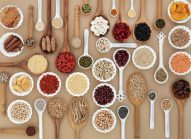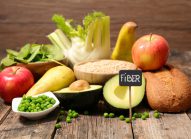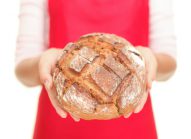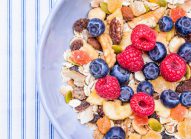- Fiber is not digested by the enzymes of the upper digestive tract
- It helps facilitate intestinal transit
- It feeds the bacteria in the colon, or gut microbiota
- Gut microbiota is an organ which impacts our health
- Some fibers are soluble, others are insoluble
- Vary your sources of fiber!
Why should we
eat some daily?
Dietary fiber is a very heterogeneous family of substances. But these substances have one thing in common: due to their chemical structure, they are neither digested nor absorbed in the small intestine. This trait is unique: proteins, carbohydrates, and lipids are absorbed in the small intestine and provide energy. For fibers, digestion and energy intake happens lower in the digestive tract: inside the colon.
For a long time, it was thought that the only role of fiber was to add bulk to the stool and clean up the large intestine, like organic waste to be eliminated naturally. In actuality, the effects of fiber go well beyond those of transit regulation. The target of these effects depends on their nature.
In practice, we distinguish between two main groups of dietary fiber:
- Fibers which naturally occur in foods and are made up of two sub-groups:
– Insoluble fibers, such as cellulose, lignin, and certain hemicelluloses, found in grain-based products, especially those with whole grains.
– Soluble fibers such as certain hemicelluloses, glucans, pectins, gums, carrageenans, resistant starch, and inulin present in fruits and vegetables, pulses, seaweed, potatoes, and grains. - Isolated and purified fibers from natural raw materials, scientifically proven to provide health benefits (such as oligofructose).
Most fibers – non-starch polysaccharides and lignin – are part of the vegetable cell membranes. These fibers are often associated with other nondigestible components such as phenolic compounds, waxes, saponins, phytates, cutin, and phytosterols. They are also fibers that are in food but not in supplements.
Why is it important to familiarize ourselves with the wide variety of dietary fibers? Simply because in order to benefit from all of their effects, it is essential to not only eat enough fibers, but also obtain them from a variety of sources each day.
Some types of dietary fiber (such as pectins, gums, fructo-oligosaccharides, and resistant starch) can be fermented by bacteria in the gut microbiota and produce. The result? Physiological effects which will impact the whole body, notably because it nourishes the gut microbiota!
Other types of dietary fiber, such as cellulose and lignin, are lightly fermented, and mainly contribute to the regulation of intestinal transit and to increasing the volume of stools.
A diet rich in fiber is a plant-based diet. And the benefits of such a diet is not limited to fiber: it is also key to taking on the planet’s challenges. Find out why!
What is
its role?
Dietary fiber associated with sufficient hydration (the more you eat, the more you need to drink) regulates the intestinal transit. The term “regulate” means that you accelerate transit when it is too slow (constipation) and slow it down when it is too fast (diarrhea). By slowing the speed of digestion, fibers also optimize the feeling of satiation, which helps us better monitor our appetite.
But this is only the tip of the iceberg. By serving as a substrate to the gut microbiota, which is a central defense and control organ in the body, fibers play a role in preventing a number of diseases, such as cardiovascular diseases, obesity, type 2 diabetes, and certain types of cancer, and even in reducing the risk of infections and inflammatory diseases, as they modulate the activity of the immune system.
What is the
recommended intake?
In order to ensure adequate intestinal functioning, in Europe, the EFSA recommends an intake of 2 g of dietary fiber per MJ of energy intake per day in children starting at age 1 (EFSA, 2010). In adults, the total quantity of dietary fiber must be equal or superior to 25 g per day for normal bowel function.
But to profit from all the beneficial affects of fibers, namely reducing the risk of cardiovascular disease, type 2 diabetes, obesity and certain cancers, an intake of 30 g per day is recommended.
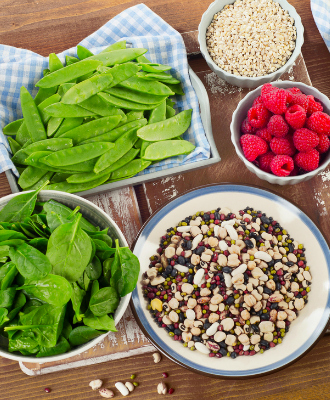
Where to find it?
Dietary fiber is essentially found in plants. The best sources are dried fruits and pulses (soybeans, lentils, chickpeas, dried beans, etc.) as well as products containing whole grains (rice, bread, pasta, flour, oats, etc.). Fruits and vegetables can also be sources of fiber or rich in fiber depending on their nature.
There is quite a high risk of vegetables being wasted – so read our tips to avoid it happening!
Foods with the
highest fiber content
| Foods with the highest fiber content | g/100g |
| Dried plums, almonds | 15-16 |
| Pitted dried apricot | 13,7 |
| Dark chocolate with 70% cocoa | 12,6 |
| Cooked artichoke | 9,4 |
| Cooked red kidney beans, cooked chickpeas, peanuts, red currant, cooked white beans, canned salsify | 8-9 |
| Cooked lentils, dried dates, hazelnuts, blackcurrant, whole wheat bread | 7-8 |
| Raspberries, raisins, cooked fava beans, chestnuts, parsley, cooked peas, blackberries, nuts | 6-7 |
| Jerusalem artichokes, raw celeriac, canned flageolet beans, chips | 5 |
| Corn flakes, cooked split peas, Brussels sprouts, biscottes (French rusks), green olives, semolina | 4-5 |
| Cooked yams, cooked parsnips, raw dandelions, raw fennel, cooked spinach, cooked green beans, baguette, country loaf | 3-4 |
| Raw sweet potatoes, cooked green cabbage, gherkins, cooked broccoli, cooked leek, raw carrots, cooked cauliflower, raw cress, raw white mushrooms, raw endives, raw red kuri squash, canned sweet corn, canned soybean sprouts, cooked turnips, cooked eggplants, cardoons, raw celery, raw red bell pepper, raw green bell pepper, cooked winter squash | 2-3 |
| Source: Ciqual |
Preconceived notions
about fiber
If you do not eat enough fiber and wish to change your diet, progressively increase your consumption of foods rich in fiber (for example, switch from white to brown bread before starting to eat whole wheat bread). You cannot go from a low-fiber diet to one rich in fiber overnight! The body needs time to adapt. And don’t forget to drink enough water!
What are
their particularities?
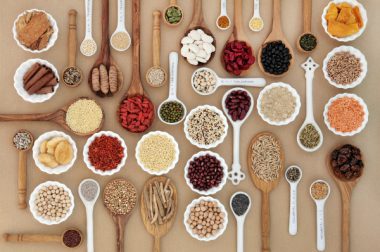
Some types of fiber are harder to digest and may irritate the bowels of the people most sensitive to it. These types of people should eat cooked fruits and vegetables, since cooking softens the fibers, making them easier to process for the body.
Vary your sources of fiber: remember that fibers are different depending on the type of food.
Grain-based products mainly contribute insoluble fibers, which have a bigger impact on intestinal transit. The more refined (and therefore less whole) the grains are, the lower their fiber content.
A third of fibers from fruits and vegetables are soluble. Pulses contain roughly 1/4 soluble fibers.
I am an ancient, fiber-rich vegetable that is great for your gut microbiota. Who am I?
What if I eat
too much or too little?
A lack of fiber in the diet negatively impacts intestinal transit. It is one of the first causes of constipation. Even in the case of chronic digestive discomfort (such as irritable bowel), it is recommended to keep eating dietary fiber, according to individual tolerance.
On the long term, insufficient dietary fiber intake increases the risk of diseases such as obesity, type 2 diabetes and cardiovascular disease.
Excess consumption of fiber is not toxic. However, ingesting too much fiber (especially the types which are fermented quickly as they get to the colon) can lead to undesirable effects such as flatulence, bloating, and diarrhea. Overconsumption is highly unlikely.
Here are some tips to eat more fiber:
- Progressively replace refined grain products with ones that are richer in fiber (brown or whole wheat bread, whole grain pasta, brown rice, breakfast cereals rich in fiber, etc.)
- Eat vegetables with the highest fiber content regularly: salsify, peas, artichokes, parsnips, cabbage, Jerusalem artichokes, spinach, etc.
- Add dried fruits to salads and meals or eat them as a snack.
- Eat pulses (lentils, fava beans and other beans, etc.) at least once per week and add them to your meals.
- Add fruits and/or vegetables to all of your meals: with yogurt or fromage blanc, in quiches, pizzas, pasta sauces, cakes, breakfast cereal, etc.
- Read the labels to find out about and compare the fiber content in different products at the store.



 Artichoke
Artichoke  Eggplant
Eggplant  Vegetable garden: growing shallot
Vegetable garden: growing shallot 










